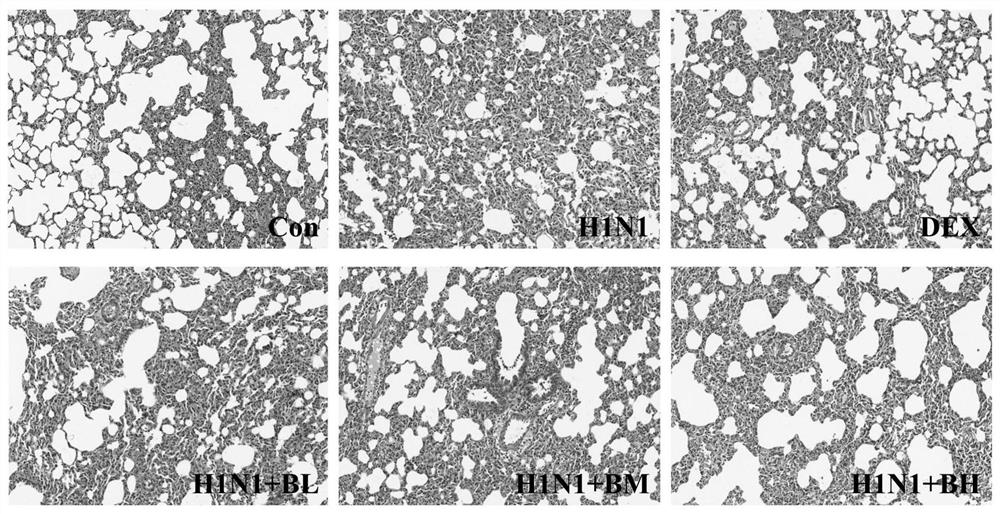Application of Baitouweng decoction in preparation of medicine for treating pneumonia
A technique of Pulsatilla decoction and Pulsatilla, applied in the field of biomedicine
- Summary
- Abstract
- Description
- Claims
- Application Information
AI Technical Summary
Problems solved by technology
Method used
Image
Examples
Embodiment 1
[0043] The preparation method of Pulsatilla Decoction, concrete steps are as follows:
[0044] According to the drug dose in "Treatise on Febrile Diseases", weigh the following raw materials respectively:
[0045] Pulsatilla 30g, Phellodendron 45g, Coptis 45g, Qinpi 45g;
[0046] All the raw materials are placed in a casserole, and the pulsatilla soup is prepared according to the following steps:
[0047] (1) Soak in 12 times the weight of distilled water for 2 hours, heat to boil on high heat, and then change to slow fire to heat after boiling; start timing from the time of boiling, filter the medicinal residue with gauze after 1 hour, and collect the water decoction.
[0048] (2) Add distilled water 10 times the weight of the raw material to the dregs obtained in the above steps, heat on high fire until boiling, then change to slow fire for 1 hour, filter with gauze, and collect the decoction.
[0049] (3) Repeat step (2), add distilled water 8 times the weight of the raw ...
Embodiment 2
[0052] The protective effect of embodiment 2 Pulsatillae decoction on mouse pneumonia induced by influenza A virus H1N1
[0053]H1N1 virus-induced pneumonia is a well-characterized, reproducible, and highly similar pneumonia model that can be used to test the therapeutic potential of BTWD.
[0054] Source of influenza A virus H1N1: provided by the Department of Microbiology and Immunology, School of Medicine, Jinan University;
[0055] Take male Balb / c mice with a body weight of 22 ± 2g, 60 in total, and randomly divide them into 6 groups, 10 in each group, respectively blank control group (Con), influenza A virus H1N1 model group (H1N1), pulsatilla Decoction BTWD low (H1N1+BL, 3.5g / kg crude drug dose), medium (H1N1+BM, 7g / kg), high (H1N1+BH, 14g / kg) dose group, dexamethasone positive drug control group (DEX, 5mg / kg).
[0056] The mice were pre-administered after 7 days of adaptive feeding. Each mouse in each treatment group was given the Pulsatilla decoction prepared in Exa...
Embodiment 3
[0064] Example 3 Pulsatilla decoction inhibits H1N1-induced pneumonia inflammatory response
[0065] By enzyme-linked immunosorbent assay (enzyme-linked immunosorbent assay, ELISA), the level of each pro-inflammatory factor in the BALF and serum of each group in Example 2 is measured, and the results are shown in the attached Figure 5 , 6 Shown:
[0066] BTWD decreased the expression levels of IL-6, IL-1β and TNF-α in BALF, and also decreased the expression levels of IL-6, IL-1β and TNF-α in serum. The above results indicated that BTWD suppressed the H1N1-mediated upregulation of TNF-α, IL-6 and IL-1β in pneumonia mice, that is, BTWD suppressed the inflammatory response of pneumonia in mice, similar to that observed in histopathology and microvascular permeability analysis The protective effect of BTWD on treatment-related pneumonia, and its mode of action may be dose-dependent.
PUM
 Login to View More
Login to View More Abstract
Description
Claims
Application Information
 Login to View More
Login to View More - R&D
- Intellectual Property
- Life Sciences
- Materials
- Tech Scout
- Unparalleled Data Quality
- Higher Quality Content
- 60% Fewer Hallucinations
Browse by: Latest US Patents, China's latest patents, Technical Efficacy Thesaurus, Application Domain, Technology Topic, Popular Technical Reports.
© 2025 PatSnap. All rights reserved.Legal|Privacy policy|Modern Slavery Act Transparency Statement|Sitemap|About US| Contact US: help@patsnap.com



